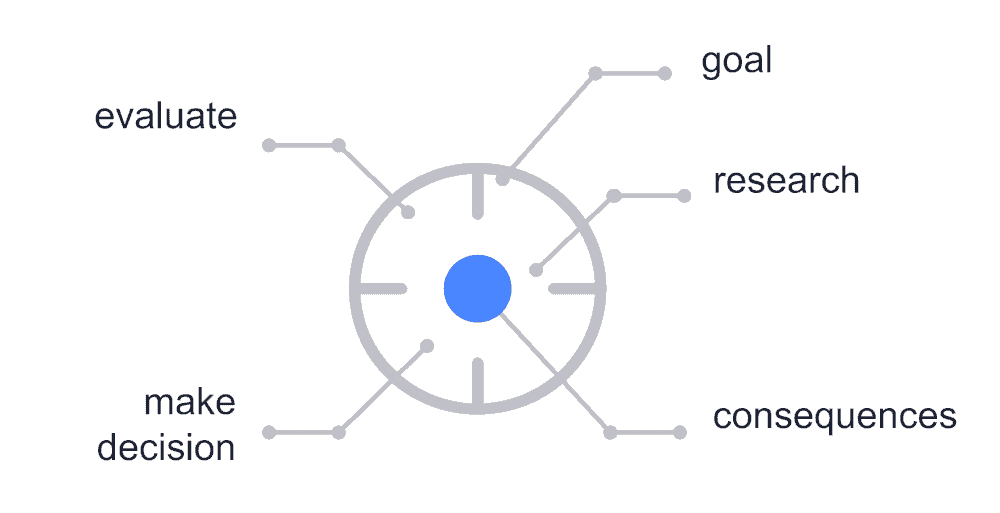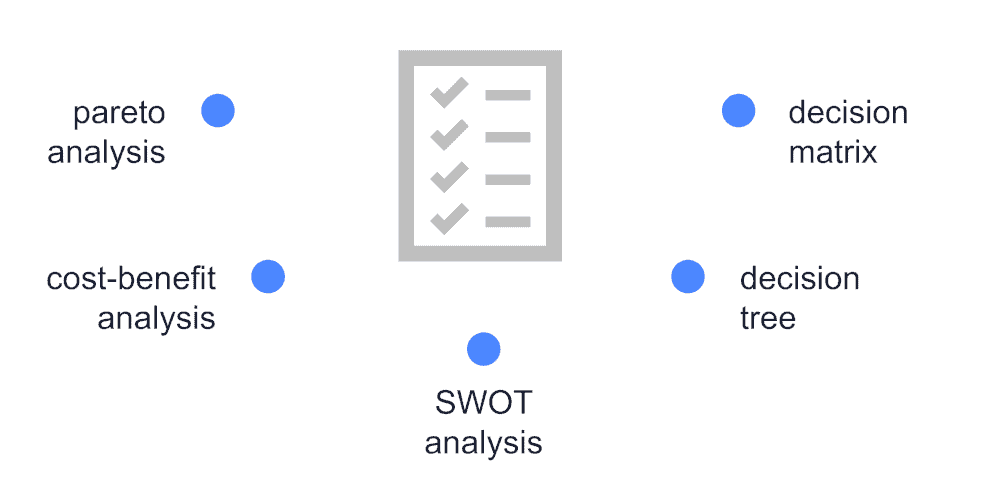Our content is reader supported, which means when you buy from links you click on, we may earn a commission.
Making Better Business Decisions, Faster

For business owners, there’s little doubt that the benefits of putting a faster and more efficient decision-making system into place are a genuinely life-changing experience for the better.
Not only can more work get completed when decision making becomes a priority, but entrepreneurs can also take on much more significant challenges in life when they begin to feel more confident about themselves and their abilities.
Indeed, creating and running a successful company often comes down to the quality of a founder’s decision-making process.
5 Steps of Decision Making
Most people first encounter these five time-honored steps of decision making in college. At that time, they get duly memorized, categorized, cataloged, and filed away in the memory archives along with massive amounts of additional information.
The next time you encounter these five steps, the experience can feel much different. This time, there is an actual decision looming in front of you. All that theory has just become all too real.

1. Goal
A good decision depends on having a clear goal. What is your goal? You start the decision-making process here.
Write down your goal. If you don’t know your goal, you can’t make a decision until you do. So do this first.
2. Research
You can think of research like your “Goal GPS.”
When you open your navigation app, it usually gives you two or three (or maybe more) potential routes to take.
Your research will generate the potential “routes” you can take to reach your goal. Some goals may only have one viable route, which makes your decision easy. But other goals may have three, five, or 10 possible routes.
3. Consequences
If you think of research like asking your GPS to map out potential routes to your goal, then consequences are like the notes that come along with each route choice.
Is there road construction or a major accident? Do you have to take highways or pay tolls? Which route is the most direct versus the most scenic?
Creating a Pros/Cons list for each route can help you weigh the benefits versus consequences that will drive your decision making.
4. Make a Decision
If you have done a good job with setting your goal, gathering your research and outlining the consequences of each option, the actual decision making part of the process will typically flow with relative ease.
The one thing to remember here is that all decisions should be made with three parts data and one part instinct, or intuition.
Sometimes a decision can look great – fabulous – on paper and still not feel right. If you run into this, it is time to circle back, look for what you may have missed, and then tackle the decision again with a fresh perspective.
5. Evaluate
There is a reason students have to take history courses in school. There is value in learning from past wins and losses. Once you have made your decision, it is made. Right or wrong, there is good to come from it in what you can learn.
Effective Tools for Decision Making
Just as a great goal can drive a great decision, so too can great tools drive a great decision-making process.
These tools are used every day in boardrooms and meeting rooms all over the world.
One of the reasons these tools continually rise to the top is because they use caters to multiple learning styles: visual/spatial, auditory/sound, kinesthetic/tactile, reading/writing.

1. Decision Matrix
Remember that Pros/Cons list from step 3 of the decision-making process here earlier?
This type of list is a great example of a decision matrix tool.
You can do a simple Pros/Cons list or get more detailed, making lists of benefits and drawbacks that are ranked on a scale from most to least beneficial or desirable.
2. Decision Tree
Visual/spatial learners tend to particularly like working with the Decision Tree tool.
This tool gets its name from its tree-like graph with its root, branches, and leaves.
- Root: the core decision on the table.
- Branch: relevant variables that could impact that core decision.
- Leaf: potential outcome from acting on each variable.
This tool is particularly powerful for use with complicated decisions. Like a tree, you can theoretically have as many branches and leaves as you can work with.
3. SWOT Analysis
SWOT stands for Strengths, Weaknesses, Opportunities, and Threats.
The SWOT tool is often created in cube format, with a cube divided into four equal sections (quadrants), with one section for each factor.
The traditional approach is as follows:
- Strengths: you can think of this as your USP (Unique Selling Proposition). Where do you shine in relation to the competition?
- Weaknesses: no one likes to admit it, but sometimes naming and studying your weaknesses can turn into your competitive superpower.
- Opportunities: both strengths and weaknesses, properly identified and understood, can help you pinpoint new opportunities to achieve your goal.
- Threats: threats may be internal or external, within your industry or in the greater general environment.
4. Cost-Benefit Analysis
Sometimes also called Marginal Analysis, a Cost-Benefit Analysis is fairly self-explanatory.
The first step is to identify each benefit and its cost(s). For example, you might have any or all of the following benefits:
- One at an equal cost.
- Another benefit at a greater cost.
- And finally, a benefit at a lesser cost.
The next step is to identify the benefit that comes to you at the least cost. Alternately, identify the cost that can deliver an exponential benefit.
5. Pareto Analysis
If you have ever heard of the 80/20 Rule, this is basically the Pareto Principle. The Pareto Principle says that 80 percent of any effect (outcomes, results) comes from 20 percent of possible causes (inputs, actions).
This whole rule actually got started with peas. An Italian economist named Vilfredo Pareto was having a little trouble in the garden. In short, not all of his pea plants were pulling their weight. With careful study and calculation, he realized that 80 percent of his yield (peas) came from 20 percent of his pea plants (pods).
Fast forward a century or two, and it turns out this 80/20 percentage is widely applicable in nearly every area of life. You just need to identify which 20 percent of your activities or inputs are driving 80 percent of your results.
Then do more of the 20 percent and less of all the rest.
Decision Making Strategies
There is no shortage of tools and models available to support your decision-making process.
In fact, it has become all too easy to get hung up on crafting visually appealing – elegant, even – tools and forget all about the reason you are using those tools in the first place!
You may start out using one tool only to realize your decision is more complex than you realized and a different tool would serve you better. Don’t be afraid to make the switch even in mid-process.
While deciding where to eat lunch doesn’t feel like a big goal to most people, deciding whether to discontinue a popular service or launch a cutting-edge new prototype product can feel positively overwhelming at first.
Here are just a few ways to make better business decisions at a higher speed.
1. Stick to Your Vision of the Big Picture
As any successful entrepreneur will tell you, it’s imperative when making an important business decision to maintain perspective on the central goals you and your company hope to achieve in the long-term.
Too often, entrepreneurs become bogged down with multiple competing interests when making an important decision. The reality is, there is nothing wrong with paring down goals to their essentials.
Reminding yourself about the desired outcomes resulting from a particular path forward will help you stay focused on the task at hand.
Conversely, trying to do everything at once will likely put a severe damper on your ability to make tough calls. As the old saying goes, entrepreneurs shouldn’t miss the forest for the trees.
2. Set a Time Limit
For many small businesses, the decision-making process often has unclear time limits. Unfortunately, it is very easy in life to put off difficult decisions … forever. (This is true for everyone; from someone completing a management internship to Bill Gates.)
Every successful business leader (just like every human being) struggles with procrastination to some degree but allowing yourself to become overwhelmed when making decisions can quickly lead to feelings of burnout and resentment. Putting a reasonable time limit in place when considering the choices ahead will keep you from creating unnecessary anxiety around the decision-making process.
3. Practice Making Small Decisions Quickly
For the typical small business owner, changing an approach to making decisions doesn’t happen overnight. Individuals who want to get better at making big decisions can make the process easier by starting with smaller and more manageable decisions to complete first.
For example, even something as simple as deciding what to make for dinner can help put a good decision-making routine into place over time.
At this stage, it doesn’t matter if the decision is correct or incorrect; just sticking to a short-term plan and seeing it through will help you feel comfortable with making fast decisions in the long run. With enough practice, more significant decisions will come naturally.
4. Use Positive Reinforcement
It is a truism in business that many high-powered professionals are hard on themselves when things don’t go right. To some degree, a desire for excellence at all times can be a good thing, but the use of negative reinforcement when it comes to making decisions often causes us to avoid making any choices whatsoever.
Rewarding yourself for merely making a quick decision will communicate to your brain that you’re on the right path forward. Reinforcing positive behaviors can have an enormous impact on how we approach tough situations in the future, and positive reinforcement is a tool every entrepreneur needs.
5. Systematize Smaller Decisions
Like the proverbial straw that broke the camel’s back, it is very easy to become overwhelmed by a slew of secondary problems in a business setting. There is an art to time management. Individuals should be OK changing their approach to solving problems when their current system isn’t working.
We shouldn’t place a premium on every single issue that comes our way. Knowing which decision to approach first can and will help you in the long run.
6. Decide Whether a Decision is Reversible
As is the case for even the greatest entrepreneurs and CEOs, uncertainty is often the fly in the ointment of an otherwise good decision-making process. There will always be some level of risk when it comes to making important business decisions. Entrepreneurs should understand that a completely risk-free decision in the business world is a rare thing indeed.
For this reason, it is essential to realize that you shouldn’t feel hemmed in by any particular decision out of a sense of pride; there is no shame in reversing a decision that hasn’t gone well or appears likely to fail. It’s all a part of the process, and no one’s judgment is entirely perfect.
If you recognize upfront that your decision is reversible, it should take some of the pressure off you to make the right one. Of course, we’d all like to make the right decision the first time, but if it’s not a make it or break it scenario, you can always give one option and try, measure the results, and if it’s worth it, decide if you want to continue moving forward with it.
7. Break Down into Steps.
Your goal (or goals) drives everything else, so start there.
Depending on how many departments, vendors, partners, or customer groups are involved, you may have to analyze and evaluate several layers of payoffs/consequences for these different groups during your research process.
8. Figure out the Decision Choices.
At this stage, it is time to take the raw data you generated from breaking down your goal into research/consequences and plug it into your tool (or tools) of choice.
This is an especially vital step if you are working with a larger remote team. You want to get your decision choices into a format that is easy to bounce back and forth, edit and add to over multiple iterations.
9. Forecast into 1-Year Timeframe.
Before making your final decision, step back, and take a good, hard look at the bigger picture.
For each potential decision on the table, consider what impact that decision will have on your company – the ripple effect – over the next 12 months.
Look at this ripple effect in your budget, workforce, risk management, sales funnels, marketing and advertising, raw materials, production, and distribution.
Can your organization afford to move in a new direction? Do you have (or can you acquire) the talent, tools, and materials you need to coincide with the timeline you need them by?
If your one-year timeline checks out, go to three years and then five years and then ten years as may be relevant.
This is precisely the type of diligent, disciplined decision making that sets true market leaders apart from the reactive rest.
Conclusion
It isn’t always easy to get in the habit of making better decisions at a faster rate, but the results can be genuinely phenomenal for business leaders of all backgrounds and management styles.
With the right approach to making tough decisions, most people will see significant improvements in many areas of their lives. Indeed, that is decision-making at its best!